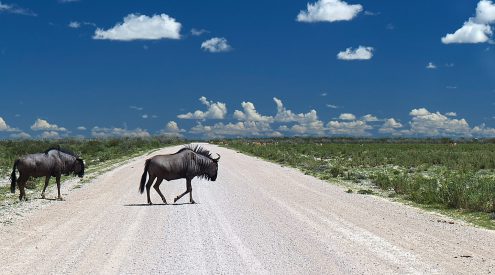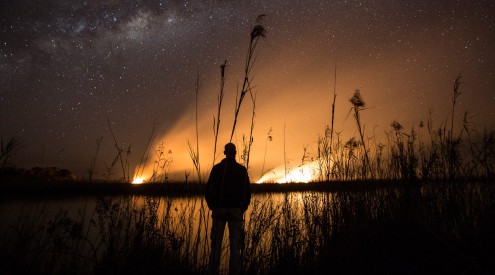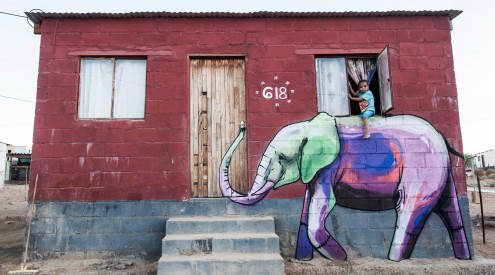There are two types of holes in Africa. The proverbial one and the one your car gets stuck in. At some point in your travels you will inevitably find yourself in either one of these situations. If you’re really unlucky, you could find yourself in both at the same time.
In 2008 my partner Mike and I set off on a two-year, 42-country expedition that would take us from our home in Cape Town, South Africa, all the way up the west coast of Africa, across Europe, Asia, India and the Arabian Peninsula, and down East Africa. We were filming a documentary on inspiring people from around the world who were trying to make a difference in their marine environments. It was a mammoth expedition that would take us through many different cultures and climates and, unfortunately, on more than one occasion on some rather unforgiving roads.
One such road was a small, non-descript track, hidden in the middle of a tropical jungle in Gabon, en route to one of the most interesting beaches found on the west coast of Africa. The reason this beach is so interesting is that because for a few months of the year it becomes swamped with prehistoric sentient creatures, which are incredibly endangered and arrive to this one beach in such great numbers you can barley walk a few meters without bumping into one. Scientifically they are called Dermochelys coriacea but they are commonly known as leatherback sea turtles. And we were determined to film them.
To get to this beach we had to make use of an old logging road where apparently we had to find a stick, which mark out another offshoot of sorts that would take us down through some swamps and to our destination. Ever the adventurers we abandoned the idea of taking the amicable well-trodden dirt road that would be a longer but much easier to drive and opted for the lesser-trodden path now that we knew one existed. Following our GPS and one sketchy, hand-drawn map we eventually found what we were looking for, but it was a very far cry from what we would class as a road. Let’s be frank, it was more of a glorified goat track than a road but we thought that at this point we could handle just about anything. Warning bells should have been ringing, but we were on the trail of leatherbacks, so we were not about to let a jungle track defeat us. We knew what we were doing.
Bad idea.
It started off rather promising, we only had a few trees to cut down, and despite the small size of the track we were making progress. That was until we hit one particular section. A few paces down the track someone laid some tree trunks; sawed in half and lashed together to form mini bridges over the very mushy looking ground we were now attempting to drive on. Unfortunately for us, a couple of elephants had obviously decided that this combination of available scratch posts and some nice wallowing would be far too tempting to leave undisturbed, and the entire length of the man-made bridge was now in muddy tatters. We made our first attempt to cross by reconstructing some of the usable pieces of the bridge, maneuvered our Cruiser’s front wheels into position, and then promptly slid off and straight into the bog.
Our entire undercarriage was wedged firmly into the mud. So we did the only thing we knew how to, dig and winch. To get the car moving we had to dig out the wheels , one at a time, trying to slide some of the flatter tree trunks along with our sand grates (which would just end up sinking into the mud) and bits of tree, leaves and whatever else we could find to try and create some traction. With the winch lashed around any large tree we could find we would haul the car onto the tree trunks, one wheel at a time, inch by inch.
The more we worked at digging out the bottom of the car, the more the mud would become stickier and slushier. As fate would have it, we found a beautiful, flat, solid, sturdy piece of ground only 50 metres from where we were now stuck. We would have to crawl toward it if we had any hope of getting out of the mud hole. Then the winch broke. And it started to get dark. And we had shared our only beer. To make matters just that much more entertaining, our only chance of help were our friends in Mayumba, a six-hour drive away, but the entire town’s electricity had just been cut, rendering cell phones a bit on the useless side (this we only found out much later). So we were on our own, and covered head to toe in mud and cuts. All we needed was for it to rain.
Then, magically the travel gods smiled down on us and our luck began to turn. Mike the mechanic managed to jimmy the winch back together using some tow rope and a bit of creative thinking. Like a movie clip of Indiana Jones hauling himself out of quicksand, our wheels were finding traction on hidden patches of solid ground and our beast of a vehicle was beginning to eat up the inches every half hour. It was now pitch dark, and every time we had to turn headlamps and car lights on we were obliterated by every manner of jungle bug that descended on us like a free buffet. But we were moving. In one final heave, 11 and a half hours of winching and digging later, at 03h00, the car was released from the muddy muck with a satisfying “˜plop’ noise, and we danced the kind of happy dance that only those who have been in similar situations will understand. As if on cue, the heavens opened up and we were drenched by a tropical thunderstorm.
Africa is the kind of continent that can bring you back down to earth, especially when you get a bit too big for your travelling boots. It can surprise you, shock you, and remind you that there is no other place quite like it on earth. Never underestimate her and never take her for granted, or she will bite you in the butt with a vengeance, or a horse fly, either way.
Oh, and if you plan on doing this kind of thing, make sure you have more than one spade.


















